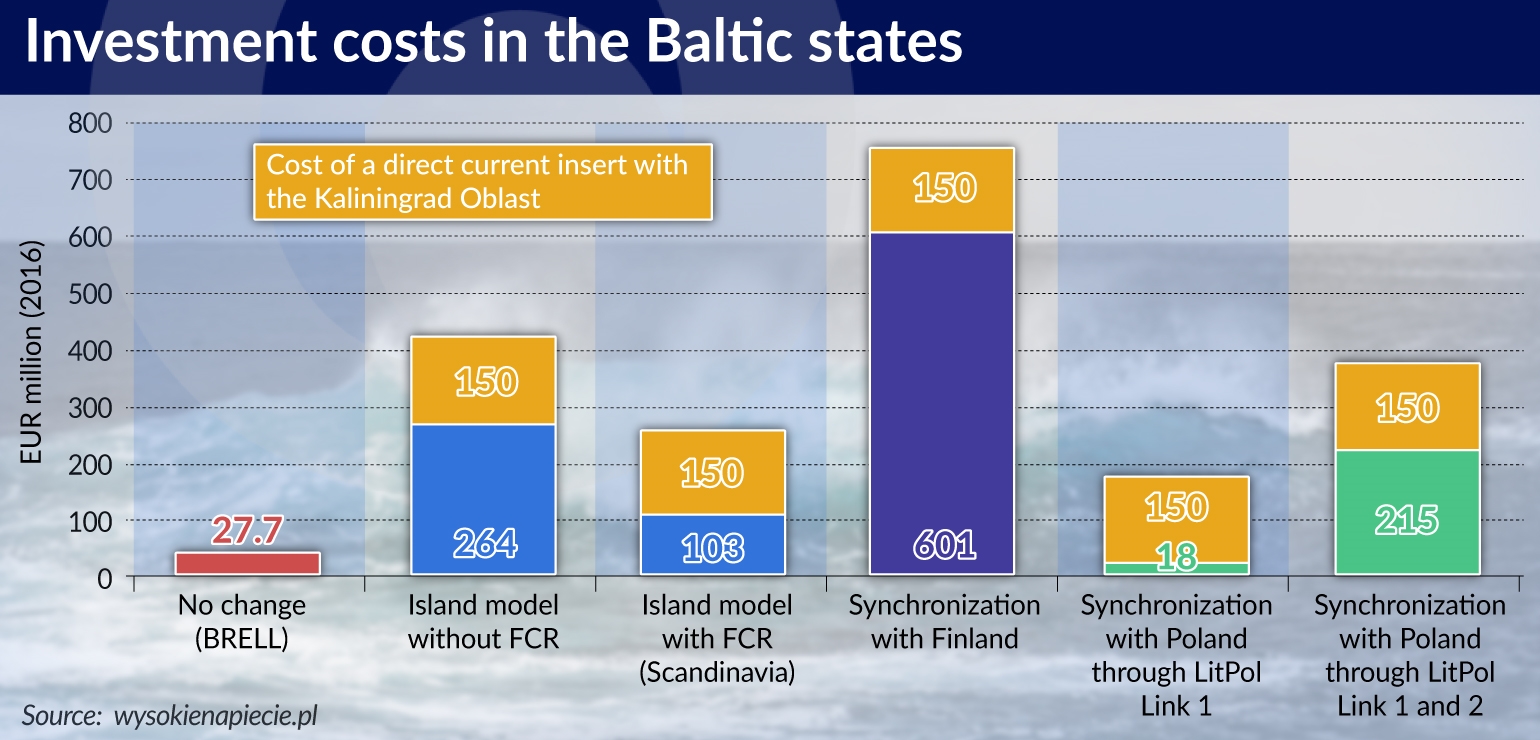Tydzień w gospodarce
Category: Raporty

Meanwhile, the Russians are also preparing to disconnect the Kaliningrad Oblast from the Baltic states, by building a small coal-fired power plant, among others.
The JRC (Joint Research Centre), which is the EU main research centre, presented the cost estimates for several scenarios under consideration in the perspective 2025, as well as several others until 2030, but under the assumption that a nuclear power plant is built in Visaginas, Lithuania. We will skip this part, because its likelihood is low.
The baseline scenario is to maintain the current state of affairs, whereby Lithuania, Latvia and Estonia remain in the post-Soviet IPS/UPS system and the BRELL ring, i.e. a grid from the times of the Soviet Union. This translates into costs of almost EUR30m for the necessary investments in the grid, and possibly to some extent in the generating capacities.
The remaining scenarios assume that the Baltic states leave the IPS/UPS system and BRELL, and each of them envisages the construction of direct current inserts on the border between Lithuania and the Kaliningrad Oblast. That would cost about EUR150m.
One could imagine that the Baltic states’ system will function in a so-called island model, without synchronization with any other area. All the inter-connectors will utilize direct current, whereby there are two options. Without the application of Frequency Containment Reserves (FCR) and with the application of Frequency Containment Reserves in cooperation with Scandinavia.
The most expensive scenario is synchronization with the Nordic system through the connections of Finland and Estonia. That would require the Nordic operators to build the appropriate systems for EUR50-100m. The total cost for all the parties was estimated at EUR1.36-1.41bn.
The cheapest version is synchronization through Poland with the use of the existing connection, or with the construction of a fully synchronous LitPol Link 2. In this case JRC estimated the total costs for all the stakeholders at EUR770-960m, including approx. EUR300m for the expansion of the Poland’s grid.
This variant was not met with enthusiasm in Poland. In March 2017, Eryk Kłossowski, the President of PSE (the Polish state-owned transmission system operator), presented the Polish idea of an alternative to a synchronous connection – a direct current cable from Władysławowo in northern Poland to Klaipeda on the Lithuanian Baltic sea coast.
In his opinion, building a new connection, close to the existing LitPol Link 1 (and that would be forced by the shape of the border), does not substantially improve the operational security parameters of the synchronized systems. Instead, it causes multiple problems at the stage of the investment process. “In the interpretation of PSE, the market study shows no significant advantages of the variant in which we build a second land connection over the maintenance of the status quo, i.e. synchronization using a single double-circuit connection,” added Kłossowski.
Meanwhile, the Baltic countries are citing the JRC report in order to justify the necessity of constructing Lit Pol Link2. This was emphasized by the end of April 2017, among others by the Estonian Minister of Economy and Infrastructure Kadri Simson, who told the BNS Agency that a single line could mean significantly higher costs for the operation of the energy systems in the Baltic states, and that it additionally reduces the safety of the supplies. Therefore, in accordance with the analyses of the European Commission, a second line must be built, and its cost should be known by the operators in the end of this year. His statement was supported by the Minister of the Economy of Latvia Arvils Ašeradens.
One of the reasons is that the desynchronization is ripping apart the post-Soviet “BRELL ring” (Belarus, Russia, Estonia, Lithuania, Latvia). It was formally created in 2001, on the basis of an agreement between these countries, which determined the conditions of energy cooperation. The BRELL ring now includes ten 330 KV lines, a number of 110 KV lines and one 750 KV line, which was left over after the shutdown of the nuclear power plant in Ignalina in Lithuania. Their combined capacity is 3000 MW.
The technical capacities of the ring are now used by both sides, but it is easy to notice that its partial liquidation also removes the influence of the system’s management headquarters, located in Moscow, on the energy systems of the Baltic states.
The Russians claim that the synchronization of the Baltic states with the West is motivated politically, and not economically, as it is unprofitable. The recipient in the Baltic states will have to bear the cost of the necessary infrastructure.
For Russia the integration of the Baltic states with ENTSO-E poses a problem, mainly due to the Kaliningrad Oblast. The possibility of its integration with the West, following the footsteps of the Baltic States, is not even considered by Moscow. Instead, the Russians are building several smaller gas power plants and a small coal power plant “Primorskaya” (195 MW).
Gazprom is supposed to build an LNG terminal (2.7 billion cubic meters per year) and a gas storage facility. Russian experts estimate the total costs of infrastructure construction associated with the enclave’s disconnection from BRELL at RUB100-150bn.
During his visit to Kaliningrad a few months ago, the Russian Energy Minister Alexander Novak also mentioned the possibility of returning to the construction of a nuclear power plant (known as the Baltic Nuclear Power Plant). In the years 2011-2010 the Russians dug out a large hole in the ground near the border with Lithuania, at the cost of approx. USD100m. The investment was abandoned because the power plant was supposed to mainly export electricity, and there were no parties interested in buying it. It seems, however, that the main purpose of Novak’s statement was to prospect for customers, who continue to be non-existent.
The article was first published by http://wysokienapiecie.pl/


